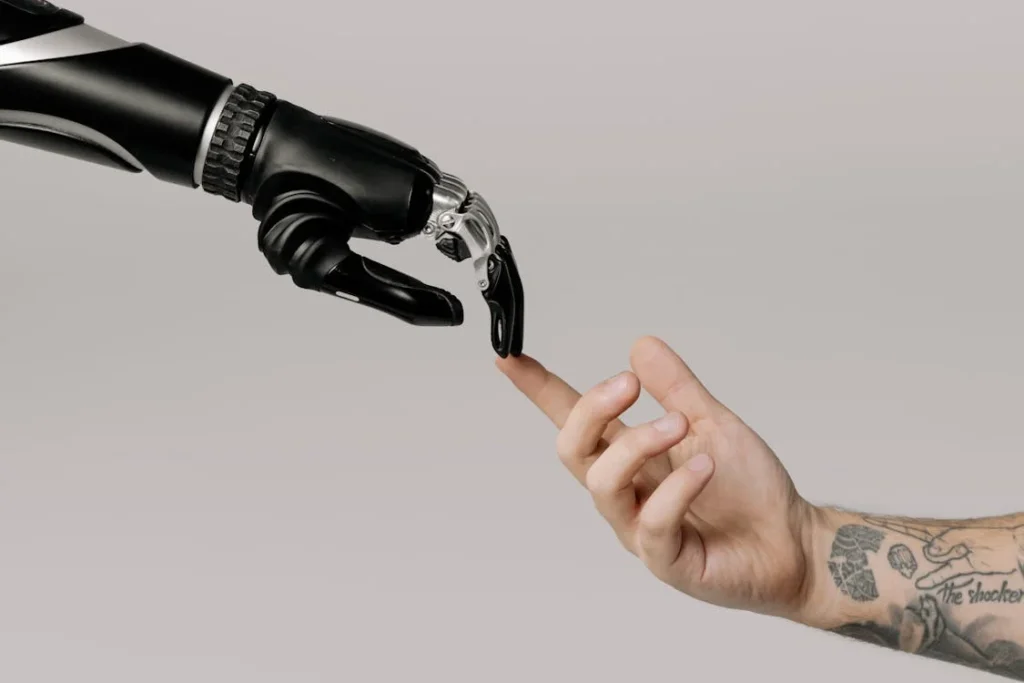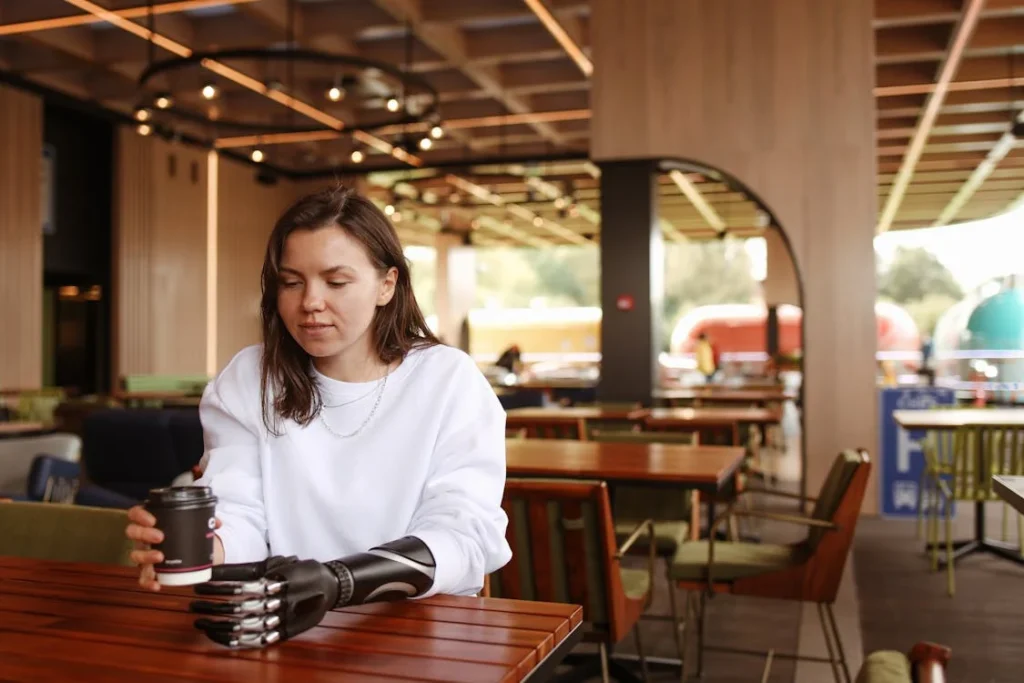Imagine losing a hand and getting a new one that doesn’t just move—it listens, learns, and talks back. Sounds like science fiction, right? But it’s not. This is the new world of connected prosthetics, where smart gripping and the Internet of Things (IoT) come together to bring you something truly magical.
At RoboBionics, we’ve always believed that technology should serve people. It should feel natural. And it should work with you, not just for you. That’s why we’re building prosthetic hands that are not just mechanical tools—but intelligent, living companions.

The Evolution of Gripping: From Mechanics to Intelligence
How Gripping Became Smarter Over Time
Not long ago, prosthetic hands were mostly stiff and basic. They helped people hold objects, yes, but they couldn’t adapt. They couldn’t sense. They couldn’t tell the difference between holding a glass of water or gripping a hammer. That meant users had to be very careful all the time. A little too much pressure, and the glass would break. Too little, and it might slip. This made everyday tasks frustrating and slow.
Over the years, engineers started adding more control features. Electric motors allowed fingers to open and close. Sensors picked up signals from muscles. And suddenly, prosthetic hands weren’t just tools—they were becoming responsive. They began to react to what the person wanted to do.
Still, something was missing. The human hand isn’t just about movement. It’s about feeling. When you pick up a pen or a hot cup of tea, your hand sends tiny messages to your brain. These signals help you adjust your grip, stay safe, and do things faster. This is where smart gripping comes in.
Smart gripping is all about mimicking what a real hand does. It adds sensors that can feel pressure. It adds tiny motors that can change grip strength automatically. It even adds software that learns from what you do every day. So if you hold a toothbrush one way, your prosthetic hand remembers that grip. If you pick up a spoon the next day, it adjusts instantly.
This is not just about technology—it’s about dignity. People don’t want to struggle with everyday tasks. They want their independence back. They want to feel confident again. Smart gripping makes this possible by giving people a hand that understands them.
At RoboBionics, we took this idea and went further. We added something powerful—something that connects everything together. We added the Internet of Things.
What Happens When You Add IoT to Prosthetics
IoT, or the Internet of Things, is what makes your phone talk to your smart TV. It’s what lets your watch count your steps and send the data to your phone. In simple words, it connects everyday devices to each other using the internet.
Now imagine your prosthetic hand being part of that smart network. It can send data to your phone. It can update its software to work better. It can even talk to your doctor or therapist in real time. This is the real magic of connected prosthetics.
Let’s say you’re wearing a bionic hand with built-in pressure sensors. As you go through your day, the hand learns which grips you use most. Maybe you often hold a water bottle, a pen, or a steering wheel. That data is sent to your phone, where an app shows how well your hand is working. It might say, “You used a pinch grip 40% of the time today.” Over time, the hand uses that data to get better at what you do. It becomes more you.
This isn’t just helpful for you—it’s helpful for your care team too. If your therapist sees that you’re struggling with a certain grip, they can adjust your training. If your doctor sees that your muscle signals are getting weaker, they can catch problems early. All of this can happen without you even stepping into a clinic.
We’ve built this into our Grippy™ hand. With our patent-pending Sense of Touch™ technology, your hand doesn’t just move—it feels. And with our smart connectivity, it learns. It gets better the more you use it. It gives you power, but also peace of mind.
Connected prosthetics also make repairs and updates easier. In the past, if something went wrong, you had to send the hand back or visit the center. Now, many issues can be fixed remotely. Updates can be pushed directly to your hand, just like a phone app update. That saves time, energy, and stress.
We are not just imagining a smarter hand—we’re building it. And we’re doing it in a way that’s affordable, made in India, and built for real people.

Why Real-Time Feedback Changes Everything
The Power of Feeling, Not Just Moving
Think about the last time you picked up something fragile. Maybe an egg, a cookie, or a plastic cup. You didn’t have to think too hard. Your fingers just “knew” how much pressure to use. That’s because your real hand sends tiny feedback signals to your brain. It tells you, “This is soft,” or “This is slippery,” or “This might break.” You respond instantly, without even noticing.
Now imagine trying to do the same thing with a hand that feels nothing. That’s what many prosthetic users had to live with for years. Even the best hands could open and close—but they couldn’t tell if they were holding something too hard or not enough. Users had to rely on their eyes. They’d watch their hand carefully to see if it was working right. That meant more stress, more guesswork, and more frustration.
This is where real-time feedback comes in. At RoboBionics, we created Sense of Touch™ to solve this. Our technology lets users feel what their hand is doing. If you grip something, tiny sensors pick up the pressure and send a gentle buzz to your arm. It’s not painful. It’s just enough to say, “Hey, you’re gripping now.” And the more pressure you apply, the stronger the signal gets. It’s like getting your natural instincts back.
Why does this matter? Because real-time feedback builds confidence. It means users no longer have to guess. They start to trust their hand. They try new things—cutting food, writing, opening jars. And the best part? They get faster and more natural at it, because their brain starts treating the prosthetic like a real part of the body.
This emotional shift is huge. It’s not just about doing tasks. It’s about feeling whole again. It’s about not being afraid to reach out, to shake someone’s hand, or to pick up a child. Real-time feedback makes the prosthetic not just useful, but personal.
Smarter Prosthetics Learn With You
We don’t all use our hands the same way. A tailor grips fabric differently than a carpenter grips a tool. A mom uses her hand differently while cooking than a student who’s typing all day. That’s why a one-size-fits-all approach doesn’t work anymore. With connected, smart prosthetics, your hand learns your life.
Every time you use your Grippy™ hand, it gathers information. It sees which gestures you repeat. It notices how strong your muscle signals are. It watches how your grip changes when you’re tired or active. Over time, the system creates a unique “map” of how you move and feel.
This isn’t just for fun. It has real, practical value. If your hand learns that your grip gets weaker by evening, it can adjust itself. Maybe it boosts grip strength automatically. Maybe it shortens your response time. Maybe it nudges you with a gentle reminder to rest. All of this helps you live better—not just function.
Even more exciting is the idea of sharing this learning. If someone else has the same kind of lifestyle or work, your grip data can help them too. This way, every Grippy™ user helps make the system smarter for everyone. We’re not just building smart hands—we’re building a smart community.
IoT allows this data to be safely shared across our platform. Everything is encrypted and secure. But the idea is simple: we grow together. Every new user adds more intelligence to the system. Every action helps shape a better future for the next person who puts on a Grippy™ hand.
This is the power of connected prosthetics. It’s not about replacing a limb. It’s about adding value to your life in ways that go beyond what nature intended.

From Device to Companion: Emotional Bonding With Smart Prosthetics
Why Emotional Connection Matters
We don’t often talk about emotions when we talk about prosthetics. But we should. Because behind every bionic hand is a person—a person who has gone through loss, who is learning to adapt, and who wants more than just a tool. They want something they can rely on. Something that feels like a part of them.
Traditional prosthetics, even the good ones, often felt cold and mechanical. They did the job, yes, but they didn’t feel like you. Users wore them, but they didn’t always love them. Many even stopped using their devices after a while. Why? Because there was no connection.
That’s changing. Smart, connected prosthetics are no longer just objects—they’re companions. They respond to your thoughts. They remember your routines. They even react to your feelings, like when your muscles get tense or tired. Over time, they feel less like a gadget and more like a partner.
We’ve seen it firsthand. When someone puts on a Grippy™ hand for the first time, it’s a big moment. But the real magic happens days or weeks later—when they stop thinking about the hand, and it just works. When they reach for a door without looking. When they hold a coffee cup without fear. That’s when the bond forms.
This bond is powerful. It gives people confidence. It makes them smile more. It brings back simple joys, like playing with a child, cooking a favorite meal, or shaking hands without worry. And because the prosthetic listens and learns, it becomes a part of the user’s story—not just something they wear, but something that grows with them.
Personalization Through Data and Daily Use
Every person is different. Some people have strong muscle signals. Others may have scars or sensitive skin. Some are super active. Others prefer a gentler, slower rhythm. That’s why personalization is so important in connected prosthetics.
Grippy™ doesn’t assume you’ll use your hand in one fixed way. It watches and learns from what you do. It tracks how long you wear the hand each day. It notices which gestures you use most often. It even sees which fingers move first when you start a grip.
Using this data, Grippy™ adapts over time. It might adjust its grip speed. It might tune the strength settings. It might give haptic feedback in a way that feels more natural to you. All of this happens quietly in the background. You don’t need to press buttons or follow a manual. The hand simply gets better the more you live your life.
This kind of deep personalization is only possible with smart, connected systems. And it’s not just about comfort—it’s about creating a seamless experience. The more natural the hand feels, the more confident the user becomes. The less they have to think about the device, the more they can enjoy life.
We’ve also built a way for users to connect with their Grippy™ hand through a smartphone. The app shows simple stats—how often you use each grip, how your signal strength changes, and more. It’s not just data—it’s a mirror into your own progress. And that motivates people. It shows them how far they’ve come. It reminds them they’re not just recovering—they’re evolving.
This is how a device becomes something more. It becomes you.

Making Smart Prosthetics Work for India
Why Affordability Is Just as Important as Innovation
In many parts of the world, advanced prosthetics are seen as luxury items. They cost more than cars. They’re imported, complicated, and usually out of reach for the very people who need them the most. In India, this has always been a major challenge. A high-tech bionic hand could cost over ₹10 lakh. That’s a dream for most families. So people had to choose: a basic limb that helped them walk or move—or nothing at all.
At RoboBionics, we believe that no one should have to choose between their dreams and their dignity. That’s why we made a different promise: to build something world-class and affordable. Our Grippy™ hand costs between ₹2.15–3 lakh. Still a big amount, yes. But far more within reach. And we’re constantly working to make it even more affordable through subsidies, CSR partnerships, and government programs.
But making it affordable is just the first step. The real goal is to make it accessible. That means building it here in India, with Indian users in mind. It means using local materials, local talent, and local insights. In fact, 60 out of Grippy’s 64 parts are proudly made in India. This isn’t just about patriotism. It’s about control. It means we can respond faster to repairs. We can upgrade parts more easily. We can serve our users with care, not just sell to them.
And because we’re based in India, we understand the ground realities. We know the power cuts, the dusty roads, the water shortages. So we built Grippy™ to be durable. It runs on a rechargeable battery. It doesn’t need fancy tools for maintenance. It’s water-resistant. It works in real-life Indian conditions—not just in labs or showrooms.
That’s what makes this more than a product. It’s a promise. A promise to bring smart technology to the people who need it most. Not in 10 years. Not in some pilot project. But now.
Building a Support System That Goes Beyond the Hand
A smart prosthetic is powerful. But it can only do so much on its own. What really makes it work is the ecosystem around it—the rehab, the guidance, the emotional support, the follow-ups. We understood that early on. That’s why we didn’t stop at building a hand. We started building a family.
We actively partner with prosthetic centers across India. From metros to smaller towns, we work hand-in-hand with clinicians, rehab specialists, and local NGOs. We train them. We support them. We help them offer Grippy™ to users in a way that feels safe, respectful, and hopeful. These partners are not just distributors—they’re caretakers. They stay with users long after the device is fitted.
We also developed a Gamified Rehabilitation App. Learning to use a smart hand can be tiring. The muscles are weak. The brain is still adjusting. That’s why our app makes practice fun. It turns rehab into a game. Users can train their grip while earning points, unlocking levels, and even challenging friends. This builds motivation. It keeps the spirit alive. It makes recovery feel like progress, not punishment.
And then there’s BrawnBand—our in-house muscle stimulator. It strengthens the arm muscles that control the prosthetic. It helps users get better signal control, faster grip response, and longer wear time. It’s not just about powering the hand. It’s about empowering the person.
This full-circle approach—smart hand, smart rehab, smart care—is what makes RoboBionics different. We don’t just ship a product and walk away. We walk with our users. We cheer for them. We learn from them.
Because at the end of the day, this isn’t just about technology. It’s about people. It’s about dreams. It’s about the little things—a mother who can braid her daughter’s hair again, a teacher who can write on the board again, a driver who can hold the wheel with pride.
That’s what connected prosthetics really mean: not just smart tools, but smarter, stronger lives.

The Road Ahead: Smarter, Lighter, and More Human
The Next Wave of Innovation in Prosthetics
We’re just getting started. What we’ve built today—a prosthetic hand that grips smartly, learns from your actions, and connects to your phone—is only the beginning. The future of connected prosthetics is going to be even more exciting, more personal, and more human.
Imagine a hand that doesn’t just react to your muscles, but also to your mood. A hand that knows when you’re tired and slows down gently. A hand that connects to your smartwatch, your voice assistant, even your home. These are not dreams. These are directions we’re already exploring.
Soon, artificial intelligence (AI) will play a bigger role. Right now, Grippy™ learns through pattern recognition—watching what grips you use most. But future models will think a step ahead. They’ll predict your movements based on time of day, your habits, and even your calendar. If it’s morning, the hand might be ready to grip a toothbrush. If it’s office time, it might prepare a typing posture. This type of contextual intelligence can make the prosthetic feel like a true extension of your body.
Weight will also drop. As components get smaller and batteries get better, bionic hands will become lighter, sleeker, and easier to wear all day. Right now, even though Grippy™ is light, we know it can be lighter. That’s why we keep refining every gear, every motor, every shell.
The hand will also get more expressive. Most users today want functionality first, but more and more people are asking for expression—can the hand show a peace sign? Can it wave? Can it signal “OK” or “thumbs up”? These small things matter. They’re part of how we communicate, how we connect with others. So we’re designing gestures that go beyond gripping. We’re bringing emotion to motion.
Then there’s material innovation. We’re testing new skins that feel more lifelike. Surfaces that are softer, more human. Surfaces that respond to temperature, touch, and moisture—just like real skin. This isn’t just about looks. It’s about comfort. It’s about the invisible stress of wearing something that doesn’t feel like you. We want to erase that stress.
And we’re not doing this in a vacuum. We listen to our users every day. Their stories shape our roadmap. A student tells us she wants to write faster. A farmer asks if the hand can grip wet tools. A chef wants better heat resistance. We take each need seriously. Because innovation doesn’t happen in labs. It happens in life.
How India Can Lead the World in Prosthetic Innovation
Most people assume the best tech comes from the West. Silicon Valley. Germany. Japan. But we believe India can lead in the future of prosthetics. Not just because we’re good at engineering, but because we build with empathy. We understand what it means to create tech that serves everyone, not just a few.
At RoboBionics, we’re showing that it’s possible to blend high science with human values. We’re combining smart chips with soft touch. We’re mixing machine learning with local wisdom. We’re building prosthetics that don’t just perform well in labs, but work beautifully in homes, streets, farms, schools, and buses.
And because we’re rooted here, we know how to scale. India has the need. India has the talent. India has the drive. With the right support—through Startup India, DPIIT, CSR programs, and healthcare networks—we can bring smart prosthetics to every corner of the country.
We dream of a future where a child in rural Bihar can wear a Grippy™ hand and attend school with pride. Where an amputee in Maharashtra can use an app to train at home. Where a working mom in Delhi can cook, care, and type without feeling limited.
This is not just about one company. It’s about a movement. A movement to build prosthetics that are not only smarter, but more human. A movement to restore what was lost—and go even further.
We believe in that future. We’re building it, every single day.

Redefining Identity: From Disability to Super-Ability
Changing How the World Sees Limb Difference
For decades, prosthetics were about hiding. They were designed to blend in, to look like the real limb that was lost. Many users were told to “cover it up,” to “make it look normal.” There was this quiet message—don’t stand out. Just try to fit in.
But something is changing. Connected prosthetics, especially smart ones like Grippy™, are flipping that idea on its head. Now, people want to show off their bionic hand. They’re proud of it. They’re taking selfies with it. They’re making videos, dancing with it, painting with it, even customizing it with bold colors. Because now, it’s not about hiding what’s missing. It’s about celebrating what’s possible.
This shift in identity is huge. It turns a story of loss into a story of strength. It replaces shame with power. And it tells the world: “I’m not broken. I’m built different.”
At RoboBionics, we’ve seen users go from shy to bold. From withdrawn to expressive. Not just because the hand works—but because it looks like something out of the future. It sparks curiosity. It starts conversations. It opens minds. And that changes how society sees limb difference—not as a weakness, but as an opportunity for innovation.
When a child walks into class wearing a robotic hand that moves with thought, other kids don’t laugh—they stare in awe. When someone gives a TED Talk wearing a connected bionic arm, they don’t get pity—they get applause. This is the power of technology meeting self-esteem.
And let’s be clear: this isn’t about turning people into machines. It’s about giving them tools to express their humanity in new ways. To reclaim their space. To feel seen, respected, and admired—not for what they’ve lost, but for who they’ve become.
Designing for Expression, Not Just Function
To support this new wave of identity, prosthetic design itself needs to evolve. It’s not enough to make the hand functional. It must be personal. It must allow the user to express their story, their style, their soul.
That’s why we’re working on modular designs—interchangeable covers, skin tones, and custom decals. Some users want a skin-toned hand. Others want neon green. Some want metallic chrome. Others want it to glow. The point is: it’s their hand. They should choose what it looks like.
We’re also exploring collaborations with artists and designers. Imagine prosthetic hands designed like street art. Or fashion lines that include bionics as part of the look. This is how we move from disability to diversity—from clinical to creative.
In the future, we see prosthetic limbs becoming cultural symbols. Not just medical devices, but wearable tech with meaning. Just like glasses or sneakers, they’ll become part of how people present themselves. And just like a tattoo or hairstyle, they’ll say something about who you are.
We want to be at the heart of that movement. Because when we give people the tools to not only function, but to shine—that’s when true dignity is restored.
Conclusion
The future of prosthetics isn’t just about machines getting smarter. It’s about people feeling stronger. It’s about hands that don’t just move—but connect, adapt, and express who you are. At RoboBionics, we’re building that future every day, right here in India. Grippy™ is more than a hand. It’s independence, it’s dignity, it’s hope you can hold.
As technology evolves, so will we—bringing down costs, lifting up lives, and rewriting what’s possible. You don’t need to hide your story anymore. With connected prosthetics, your story becomes your strength.
If you or someone you know is ready to take the next step, we’re here for you. Let’s build something extraordinary—together.
👉 Book your free demo today and experience the future in your own hands.



